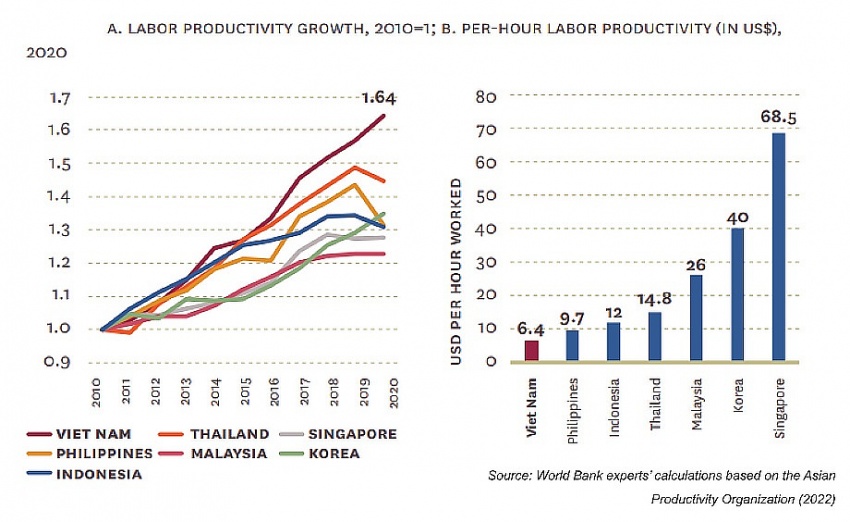Productivity must play bigger role
 |
The World Bank has warned Vietnam to ameliorate its productivity growth, which remains relatively weak now.
“Productivity growth will be key to sustaining Vietnam’s economic miracle. Vietnam’s labour productivity (LP) grew by about two-thirds since 2010, faster than all its regional peers, largely driven by improvements in the business environment, increases in the quality of human capital, and large inflows of foreign direct investment,” the bank said in a report released last month. “However, despite recent growth, LP levels are well below their peers (see chart).”
According to a 2022 survey by the International Monetary Fund, the average firm-level total factor productivity (TFP) in Vietnam grew by less than 2 per cent between 2014 and 2018, below the levels seen in many East Asian economies.
Meanwhile, the World Bank also cited statistics from the Organisation for Economic Co-operation and Development as showing that Vietnam’s TFP growth has also played a relatively small role in Vietnam’s rapid GDP growth, contributing only about 1.5 percentage points to GDP growth during 2015-2019.
“Vietnam needs to increase productivity of the domestic private sector to meet its target of becoming high income by 2045. Sustaining the average GDP growth of 5.9 per cent per year needed to achieve the ambitious 2045 target will require increasing the productivity of the domestic private sector,” said the World Bank.
It said that the role of a private sector-led productivity growth will be especially important as the country’s historic sources of growth are gradually losing steam: capital accumulation is constrained by relatively low public investment due to a conservative fiscal policy and implementation challenges, while the contribution of labour supply is also declining due to fast ageing.
“This leaves productivity growth, in addition to further private sector capital accumulation, as the key growth engine going forward,” the bank stated.
Vietnam’s LP is estimated to increase 3.77-4.76 per cent last year, far lower than the National Assembly’s goal of 5-6 per cent, also meaning that this has been the third year in a row that the country failed to reach the LP growth target. The average LP increase is on the decrease, as it is far lower than the average of over 6 per cent for the 2016-2020 period.
According to the International Labour Organization, by late 2022, Vietnam’s LP was tantamount to 12.2 per cent of Singapore, 24.4 per cent of South Korea, 58.9 per cent of China, 63.9 per cent of Thailand, and 94.2 per cent of the Philippines.
Meanwhile, the Asia Productivity Organization has also assessed that Vietnam’s LP is about 60 years behind that of Japan, 40 years of Malaysia, and 10 years of Thailand.
This year, the government has set a target that the LP will climb 4.8-5.3 per cent. The Ministry of Planning and Investment (MPI) is now mulling over producing a scheme on establishing a national productivity committee. The scheme is set to be completed by the end of this year.
According to the latest report from the the MPI, Vietnam will need about 50,000-100,000 high-skilled workers for the semiconductor sector alone for the 2025-2030 period.
In 2021, total development investment into scientific and technological activities hit $1.33 billion, responsible for only 1.85 per cent of the economy’s total development investment capital. The sum decreased to $1.3 billion in 2022, accounting for 1.48 per cent.
The state budget for such activities and research and development also remained at a low level of 0.58 per cent in 2021 – lower than the rate in 2019 of Malaysia (1.13 per cent) and Singapore (2.2 per cent). Statistics for last year are not yet available.
The World Bank suggested that productivity in Vietnam can grow by improving the efficiency of the existing firms, including by improving managerial practices, adopting new technologies, and enhancing access to markets and finance. It can also be improved by the state’s readiness in reallocating resources between firms and sectors from less efficient to more efficient firms and industries.
What is more, productivity can also grow via the state allowing higher-productivity firms, mostly innovative startups, to enter and low-productivity firms to exit the market.
“High-productivity, innovative startups can play a key role in creating higher quality jobs, creating new markets and disrupting existing ones, and boosting the productivity of the Vietnamese domestic private sector. The entrepreneurs who would build innovative startups require conducive enabling environments, in the form of an entrepreneurial ecosystem, to build and growth their firms,” the World Bank stated.
 | Vietnam’s labour productivity needs to catch up with ASEAN Vietnam’s labour productivity has improved but is still low in comparison with other ASEAN members, according to a report by the Ministry of Planning and Investment. |
What the stars mean:
★ Poor ★ ★ Promising ★★★ Good ★★★★ Very good ★★★★★ Exceptional
Related Contents
Latest News
More News
- Vietnam's top 500 value-creating enterprises announced (December 27, 2025 | 08:00)
- The PAN Group shaping a better future with ESG strategy (December 26, 2025 | 09:00)
- Masan Consumer officially lists on HSX, marking the next phase of value creation (December 25, 2025 | 13:20)
- MCH to become the largest consumer stock on VN-Index (December 24, 2025 | 11:05)
- Oil and gas firms post strong 2025 results (December 22, 2025 | 17:42)
- SABECO wins multiple international beer awards (December 22, 2025 | 17:41)
- UOB sees Vietnam growth easing in fourth quarter (December 22, 2025 | 17:39)
- First members of Danang International Finance Centre revealed (December 22, 2025 | 17:39)
- Human-centred governance seen as key to AI development (December 19, 2025 | 18:19)
- Top 10 notable events of Vietnam’s industry and trade sector in 2025 (December 19, 2025 | 14:00)

 Tag:
Tag:





















 Mobile Version
Mobile Version